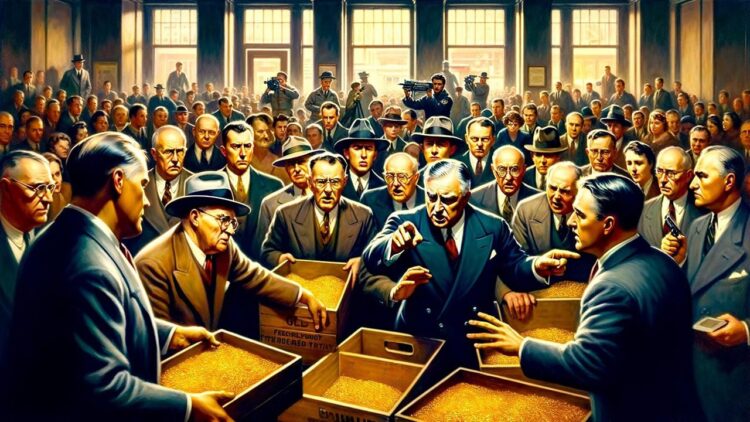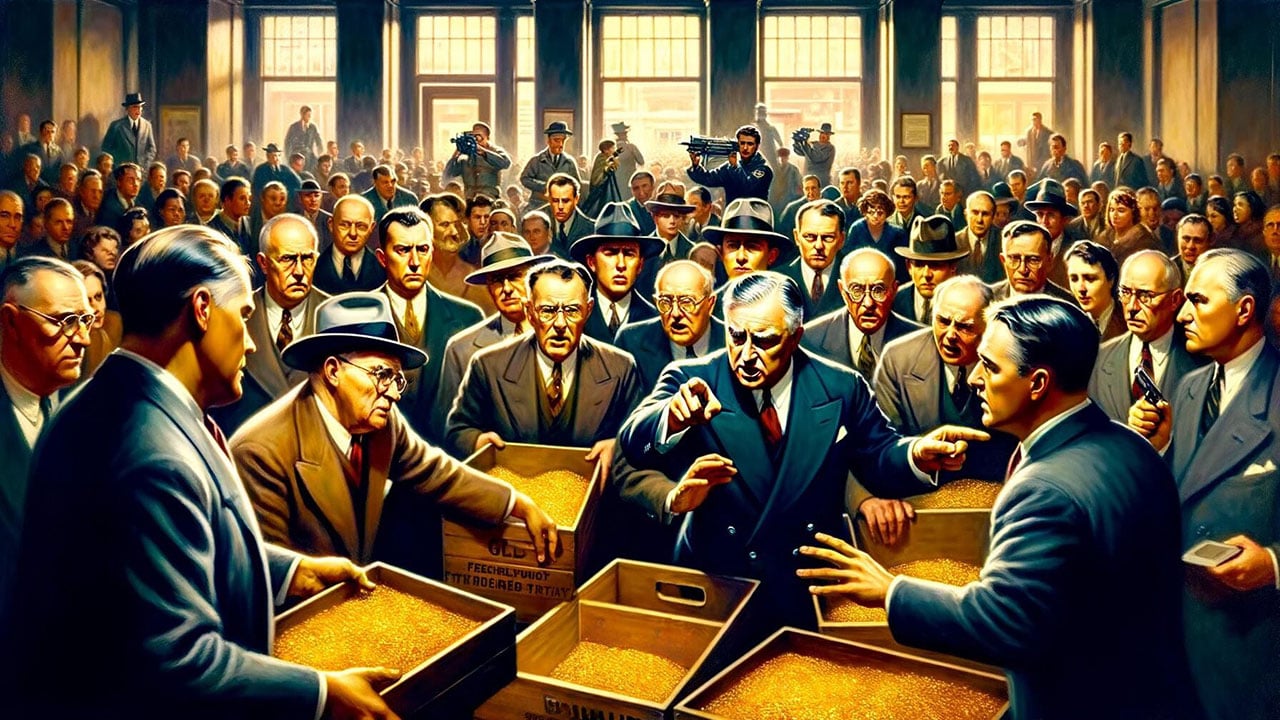
 By Jp Cortez, Sound Money Defense LeagueToday, states across the country are beginning to actively embrace pro-sound money legislation, inviting a critical examination of how America abandoned the gold standard of money and racked up $34.5 trillion in debt. To understand how we got here, it’s important to understand the policy that initiated our monetary decline. 91 years ago, on April 5th, 1933, President Franklin D. Roosevelt issued Executive Order 6102, forever reshaping America’s monetary system. This controversial order marked a pivotal moment in the nation’s financial history. EO 6102 banned private ownership of gold coins, bullion, and gold certificates with the penalty for noncompliance being up to ten years in prison, a fine of $10,000, or both. This draconian edict also signaled the effective end of the gold standard.America did not always have unbacked, paper money. In fact, America’s founders spilled a lot of ink warning against the risks and ravages of fiat currencies.In 1786, George Washington wrote to Thomas Jefferson, “Paper money has had the effect in your state that it will ever have, to ruin commerce, oppress the honest, and open the door to every species of fraud and injustice.”James Madison wrote that “paper money is unjust” and “unconstitutional.”To enshrine honest money, they considered gold and silver the foundation. Gold and silver are notably the only form of money mentioned in the U.S. Constitution (Article 1, Section 10).“No State shall…make any Thing but gold and silver coin a tender in payment of debts.”The Coinage Act of 1792 established the U.S. Mint and regulated the coinage of gold, silver, and copper coins. The dollar was defined in terms of a specific weight of silver or gold, providing a tangible link between the currency and precious metals.Under the gold standard, the U.S. dollar was directly convertible to a fixed amount of gold. This system provided stability and confidence in the currency, as the value of money could not be printed ad nauseam, but was tied to a tangible and finite resource.As the nation expanded and industrialized, the gold standard emerged as a cornerstone of America’s economic might, and the gold-backed U.S. dollar would eventually become the world’s reserve currency.The gold standard buttressed the Gilded Age of the 19th and early 20th centuries, providing a necessary, if not sufficient, condition to unseen leaps forward in economic stability, international trade, and human prosperity.In response to the economic turmoil of the Great Depression, President Franklin D. Roosevelt banned private ownership of gold with Executive Order 6102, marking an important nail in the coffin of the gold standard in the United States.In 1933, Congress passed the Gold Reserve Act, which granted the President the power to further manipulate America’s currency by adjusting the gold content of the dollar. Subsequently, President Roosevelt devalued the U.S. dollar by increasing the price of gold.In 1934, the Gold Reserve Act allowed the government to hold gold at a higher price, effectively devaluing the dollar and further detaching it from its gold-backed origins.Towards the end of WWII, a new international monetary system was created at an international conference in Bretton Woods, New Hampshire in 1944, pegging major currencies to the U.S. dollar, which remained convertible to gold. However, mounting economic pressures and trade imbalances eventually led to the “temporary” abandonment of the gold standard in 1971 under President Richard Nixon.Nothing is so permanent as a temporary government program. Today’s Federal Reserve Note is printed endlessly and spent haphazardly, unshackled from any restraint. As a consequence, the national debt is now growing at a rate of $1 trillion about every 100 days.According to economist Michael Bordo, the gold standard provided long-term stability, evidenced by an average annual inflation rate of .1 percent between 1880 and 1914, compared to the average inflation rate of 4.1 percent from 1946 to 2003.The abandonment of sound money principles allowed for unprecedented government spending, particularly during times of war. With the ability to print fiat currency unconstrained by the discipline of a gold standard, the government financed World War II and subsequent conflicts through inflationary measures.The government’s ability to print endlessly has enabled endless war.This unchecked power to create currency out of nothing has not only led to an expansion of the national debt but also facilitated increased expansion of controversial and fiscally unsustainable policies, such as the literal Ponzi scheme that is America’s entitlement programs.Restoring sound money is an uphill battle, but significant victories are being won across the country. In 2023, the Sound Money Defense League effectively helped pass pro-sound money legislation in Tennessee, Mississippi, Oregon, Arkansas, and Florida.So far in 2024, Governors in Utah and Wisconsin have signed pro-sound money legislation into law. Other sound money legislation has already been introduced and advanced in Oklahoma, New Jersey, Idaho, Iowa, Nebraska, Kentucky, Georgia, Utah, Alaska, Hawaii, Kansas, Louisiana, Mississippi, Missouri, New Hampshire, North Carolina, Tennessee, Vermont, and West Virginia. April 5th, 1933 may be a somber chapter in American history, but there is a brighter future ahead.
By Jp Cortez, Sound Money Defense LeagueToday, states across the country are beginning to actively embrace pro-sound money legislation, inviting a critical examination of how America abandoned the gold standard of money and racked up $34.5 trillion in debt. To understand how we got here, it’s important to understand the policy that initiated our monetary decline. 91 years ago, on April 5th, 1933, President Franklin D. Roosevelt issued Executive Order 6102, forever reshaping America’s monetary system. This controversial order marked a pivotal moment in the nation’s financial history. EO 6102 banned private ownership of gold coins, bullion, and gold certificates with the penalty for noncompliance being up to ten years in prison, a fine of $10,000, or both. This draconian edict also signaled the effective end of the gold standard.America did not always have unbacked, paper money. In fact, America’s founders spilled a lot of ink warning against the risks and ravages of fiat currencies.In 1786, George Washington wrote to Thomas Jefferson, “Paper money has had the effect in your state that it will ever have, to ruin commerce, oppress the honest, and open the door to every species of fraud and injustice.”James Madison wrote that “paper money is unjust” and “unconstitutional.”To enshrine honest money, they considered gold and silver the foundation. Gold and silver are notably the only form of money mentioned in the U.S. Constitution (Article 1, Section 10).“No State shall…make any Thing but gold and silver coin a tender in payment of debts.”The Coinage Act of 1792 established the U.S. Mint and regulated the coinage of gold, silver, and copper coins. The dollar was defined in terms of a specific weight of silver or gold, providing a tangible link between the currency and precious metals.Under the gold standard, the U.S. dollar was directly convertible to a fixed amount of gold. This system provided stability and confidence in the currency, as the value of money could not be printed ad nauseam, but was tied to a tangible and finite resource.As the nation expanded and industrialized, the gold standard emerged as a cornerstone of America’s economic might, and the gold-backed U.S. dollar would eventually become the world’s reserve currency.The gold standard buttressed the Gilded Age of the 19th and early 20th centuries, providing a necessary, if not sufficient, condition to unseen leaps forward in economic stability, international trade, and human prosperity.In response to the economic turmoil of the Great Depression, President Franklin D. Roosevelt banned private ownership of gold with Executive Order 6102, marking an important nail in the coffin of the gold standard in the United States.In 1933, Congress passed the Gold Reserve Act, which granted the President the power to further manipulate America’s currency by adjusting the gold content of the dollar. Subsequently, President Roosevelt devalued the U.S. dollar by increasing the price of gold.In 1934, the Gold Reserve Act allowed the government to hold gold at a higher price, effectively devaluing the dollar and further detaching it from its gold-backed origins.Towards the end of WWII, a new international monetary system was created at an international conference in Bretton Woods, New Hampshire in 1944, pegging major currencies to the U.S. dollar, which remained convertible to gold. However, mounting economic pressures and trade imbalances eventually led to the “temporary” abandonment of the gold standard in 1971 under President Richard Nixon.Nothing is so permanent as a temporary government program. Today’s Federal Reserve Note is printed endlessly and spent haphazardly, unshackled from any restraint. As a consequence, the national debt is now growing at a rate of $1 trillion about every 100 days.According to economist Michael Bordo, the gold standard provided long-term stability, evidenced by an average annual inflation rate of .1 percent between 1880 and 1914, compared to the average inflation rate of 4.1 percent from 1946 to 2003.The abandonment of sound money principles allowed for unprecedented government spending, particularly during times of war. With the ability to print fiat currency unconstrained by the discipline of a gold standard, the government financed World War II and subsequent conflicts through inflationary measures.The government’s ability to print endlessly has enabled endless war.This unchecked power to create currency out of nothing has not only led to an expansion of the national debt but also facilitated increased expansion of controversial and fiscally unsustainable policies, such as the literal Ponzi scheme that is America’s entitlement programs.Restoring sound money is an uphill battle, but significant victories are being won across the country. In 2023, the Sound Money Defense League effectively helped pass pro-sound money legislation in Tennessee, Mississippi, Oregon, Arkansas, and Florida.So far in 2024, Governors in Utah and Wisconsin have signed pro-sound money legislation into law. Other sound money legislation has already been introduced and advanced in Oklahoma, New Jersey, Idaho, Iowa, Nebraska, Kentucky, Georgia, Utah, Alaska, Hawaii, Kansas, Louisiana, Mississippi, Missouri, New Hampshire, North Carolina, Tennessee, Vermont, and West Virginia. April 5th, 1933 may be a somber chapter in American history, but there is a brighter future ahead.
Today, states themselves are actively engaged in the pursuit of sound money, and its underlying principles of freedom, stability, and fiscal responsibility for a more prosperous tomorrow. Jp Cortez is the executive director for the Sound Money Defense League, and a Young Voices contributor. His analysis and commentary have appeared in Reuters, Business Insider, HuffPost, and more. Follow him on Twitter @JpCortez27.More By This Author:The Real Minimum Wage Is Always Zero No Matter What Politicians Say
What Is The Gold-Silver Ratio? Why Should We Pay Attention To It?
Grassroots Efforts Help Push Gold And Silver Sales Tax Repeal Over The Line In Wisconsin















